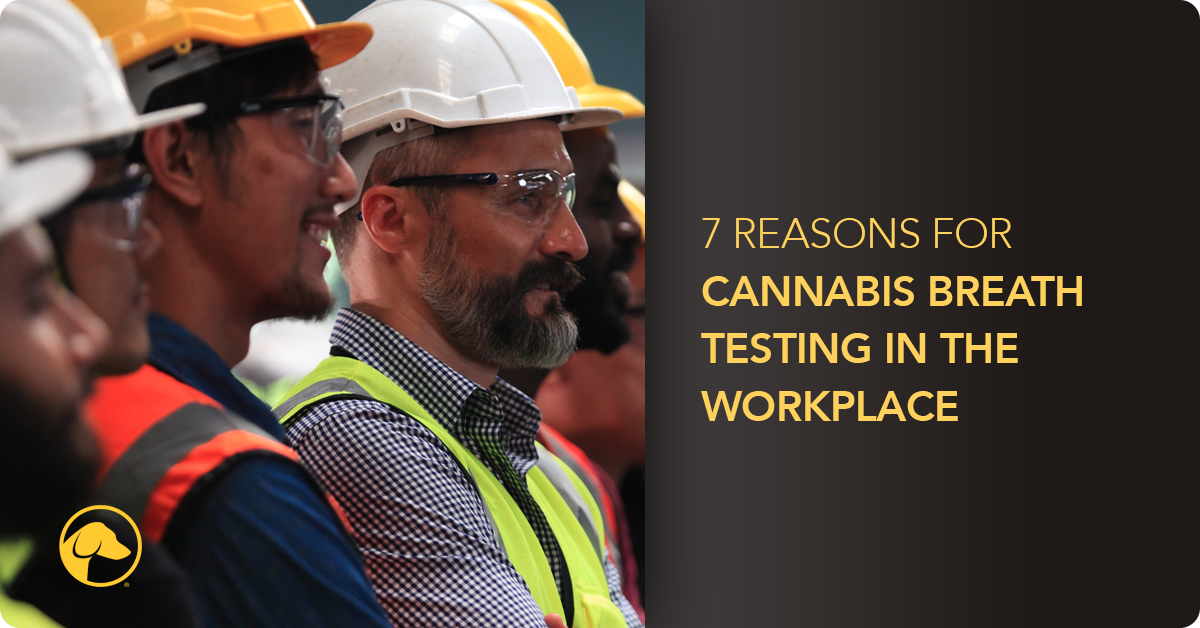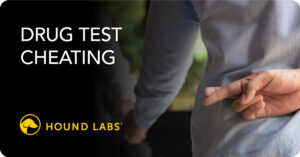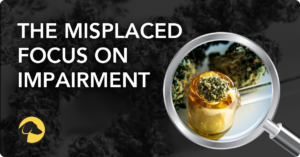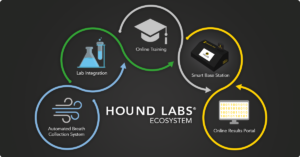
Seven Ways to Confront Workday Cannabis Use
We are approaching 4/20, a day many cannabis enthusiasts set aside to celebrate the movement and how far it’s come, with recreational marijuana now allowed in 24 states plus the nation’s capital. Marijuana now accounts for more than half of all positive drug tests, and our latest in-house study of more than 500 employees who use cannabis before or during work indicates 53% of respondents admit to daily use.
In this era of cannabis legalization and widespread use, zero-tolerance policies are no longer practical or enforceable when results are based on legacy drug testing methods with long windows of detection. Few employers can afford to risk turning away qualified candidates or lose valuable employees who may fail to pass conventional tests due to off-duty cannabis use. On-the-job use, however, presents significant risks for your business.
Implementing a cannabis breath test can help you enforce policies that prohibit use just before or during the workday but do not penalize use outside of work. Aaron Atkinson, Executive Vice President of Marketing at Hound Labs, and Vince Bonomo, one of our senior customer success leaders, recently presented a webinar titled, “7 Ways to Implement Cannabis Breath Testing.” The session describes when and where breath testing can be leveraged in the workplace, as well as how cannabis policies can be updated to account for a recent use test.
Whether you have an established drug testing program or are considering onboarding a new test type, it’s time to act. Consider these seven testing scenarios to see which could be a good fit for your organization.
PRE-EMPLOYMENT
Pre-employment testing is performed after a conditional offer of employment. A negative result is required before an applicant starts working.
Pre-employment testing can be an effective deterrent to workday cannabis use. It sets a precedent for ongoing testing, helping deter on-the-job use once employees are hired. Using a breath test that detects only recent use gives you an advantage in the hiring process. It expands your applicant pool and presents a safer alternative to eliminating cannabis testing. A negative breath test result indicates a candidate has not used cannabis just before or during the workday. “This is sometimes seen as the IQ test of drug testing methods because it can help companies ensure they are hiring candidates whose behaviors align with company policies,” says Aaron Atkinson.
As candidates seek employment, they can be assured of remaining in compliance by continuing to avoid cannabis use as outlined in the company’s policy. Additionally, a breath test complies with new legislation in some states that prohibits the discrimination of candidates based on off-duty use.
ONBOARDING
Onboarding testing involves screening all new employees within a predefined period after their date of initial employment as outlined in a company’s drug testing policy.
While some states are beginning to adopt employment protections for cannabis users, many workplace testing policies are not aligned with new legislation. Under these new laws in states like California and Washington, employers can no longer rely on urine and hair testing methods that reflect metabolite-based, off-the-job cannabis use. Instead, tests are actionable only if they reflect recent use that occurs within the workday. With the industry’s shortest detection window for cannabis, breath testing limits detection to just a few hours after use and provides a viable alternative to conventional testing methods.
Incorporating a cannabis breath test during onboarding helps set the expectation for ongoing testing throughout an employee’s tenure. It presents an opportunity to educate employees on testing policies – outlining when and how testing is performed, which positions undergo testing, and what to expect from testing results. A mutual understanding of testing policies can help achieve the ultimate goals of testing – building a culture of safety and treating all employees fairly and objectively.
PRE-ACCESS
Pre-access testing specifies testing employees for recent cannabis use upon workplace arrival, with a negative result required for site access and to begin work.
Testing employees before they enter the workplace, or even when they return from breaks, can directly improve safety and productivity among employees. This is true, especially for safety-sensitive roles such as construction and heavy machinery operations, where an employee’s performance can greatly impact both their safety and that of others.
In modern work environments, the term safety-sensitive has expanded to new roles such as cyber, fiscal, and brand security. Employees with access to sensitive information like company finances, trade secrets, and personal information can’t risk a mishap that could jeopardize company data, revenue, or reputation. A cannabis breath test provides objective information about whether an employee has used at or before coming to work, helping limit access to anyone who presents a risk due to recent use.
RANDOM
Random testing describes the unscheduled testing of employees using a scientifically valid random selection process based on pre-defined criteria.
As an alternative to removing cannabis testing from your program, a random breath testing strategy helps prevent workplace incidents before they occur. Regular random testing demonstrates your commitment to creating a safe work environment and offers liability protection should an incident occur. “Random testing is like an insurance policy for employers. Prevention and deterrence are the keys of this testing method,” says Vince Bonomo.
A random selection process also establishes objectivity in testing by helping to ensure your program is free from bias or subjectivity. The anticipated outcome of a random breath test is a negative result that rules out recent cannabis use. However, if results indicate recent use and a violation of company policy, employers have options to remediate through stand-down procedures, second chance programs, or other avenues based on company policy.
These initial testing reasons – pre-employment, onboarding, pre-access, and random – all focus on risk prevention. They take place before an incident occurs and before an employer incurs the cost or consequence of workplace use. “In the reasons that follow, testing occurs after an incident has already occurred. While still necessary and valuable, prevention represents the true aim and ROI of drug testing,” explains Aaron.
POST-INCIDENT
Post-incident testing involves screening an employee or team involved, or associated with, a workplace incident such as an accident, theft, or damage to property or equipment.
When workplace incidents occur, drug use must be ruled out as a contributing factor. A conventional test, however, may indicate the presence of THC even if an employee used cannabis days or weeks before the incident occurred. Taking adverse action against an employee for an incident based on unrelated use presents a variety of potential risks ranging from termination of the employee to litigation against the employer. “Similar to fire prevention, the goal of testing is to keep drug use out of the workplace before it causes any damage,” says Aaron. “If an incident does occur, post-incident testing can help employers figure out how it started and how to keep it from happening in the future.”
In these scenarios, you can’t afford to make inaccurate conclusions based on irrelevant results. A breath test specifically isolates use within a few hours after consumption, offering objective data to determine whether use occurred in a timeframe that could have played a role in the incident. This can help identify policy violations and protect those who follow company policies.
REASONABLE SUSPICION
Employee reasonable suspicion testing enables the employer to screen when there is evidence or reasonable cause to suspect drug use.
On occasion, you may observe employees with an inability to complete routine tasks, the loss of motor skills, or changes in appearance. These behaviors can stem from any number of conditions. When concerning behaviors are observed, however, testing may be a logical avenue to determine if drug use may be involved. “When an employer observes a reason for testing, breath testing provides a method to support or disprove their suspicion,” says Vince. “Recent use testing helps identify a potential risk before that risk manifests.”
In these reasonable suspicion scenarios, a negative breath test can help rule out recent cannabis use as a contributing factor. After being cleared, the employee may be able to return to work in some cases. In others, you may decide to pursue additional drug testing, medical evaluation, mental health support, or temporary leave as alternatives. Procedures can be outlined in company policy so both employees and supervisors are aware of the options.
RETURN-TO-DUTY
Return-to-duty testing involves screening employees who are returning to work after an extended leave or after a previous positive test that violated the employer’s drug testing policy.
In cases where an employee fails to adhere to company policy, return-to-duty testing provides an alternative to a zero-tolerance approach. Instead of terminating someone following a first offense, you can support and retain the employee while testing for recent use to help dissuade a repeat violation.
This approach offers a second chance to employees after a policy violation. At the same time, it provides a fair and objective method to test those who may present a higher risk for repeat violations, supporting a culture of safety for all employees.
GET STARTED TODAY
As cannabis laws change nationwide, clear and comprehensive drug testing policies are needed to help ensure consistency and fairness, eliminating surprises for both employees and applicants. Specifically testing for and isolating recent use can help companies retain employees while maintaining programs that promote safety, improve job performance, and prevent costly incidents.
“Discontinuing THC testing is a bit like dropping an insurance policy when the risks are higher than ever,” advises Aaron. “If employees are failing drug tests for cannabis, the solution isn’t to stop testing for it. Breath testing offers a more intelligent way to test leveraging new tools to optimize testing programs.”
Cannabis breath testing provides the objective data you need to enforce policies restricting cannabis use at or before work. Breath tests can be added to existing drug testing methodologies and applied throughout the employment continuum. Whether you select just one or the full range of applications, the addition of cannabis breath testing can help deter on-the-job use and foster a culture of policy adherence in your testing program.
Contact us to get started today or read our eBook on these seven testing scenarios.

April 18, 2024
By TRICIA O'CONNOR
Director of Content + Brand Strategy
Share











